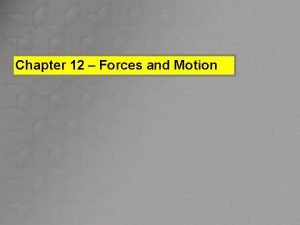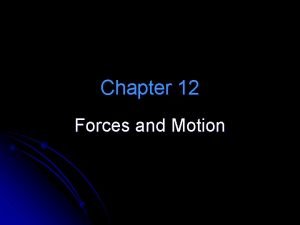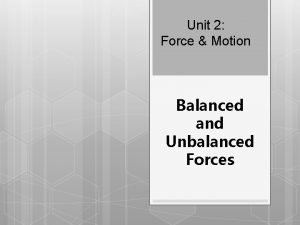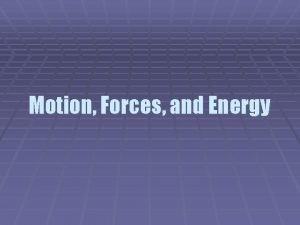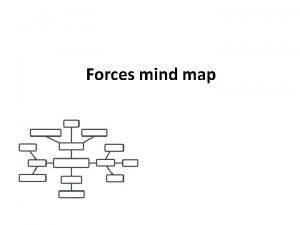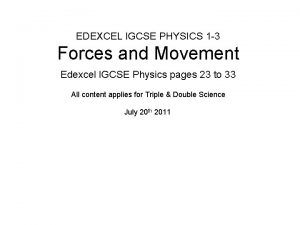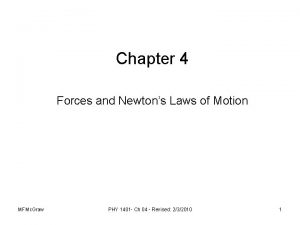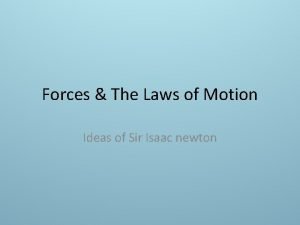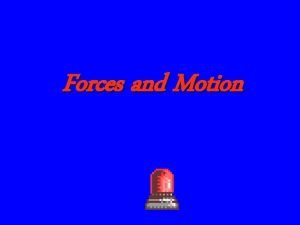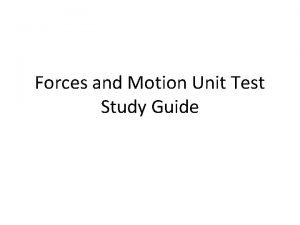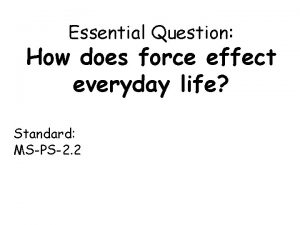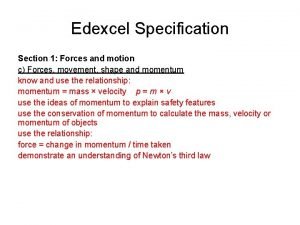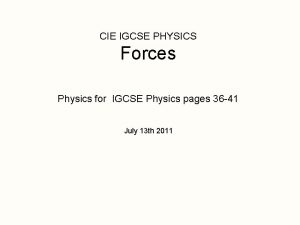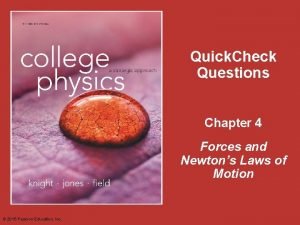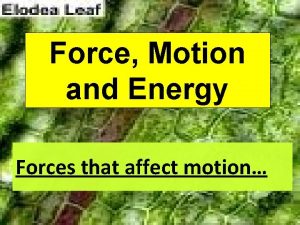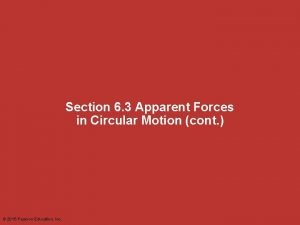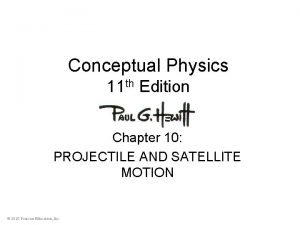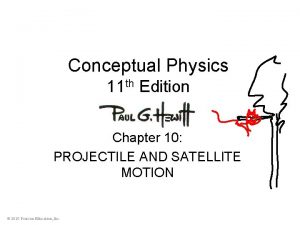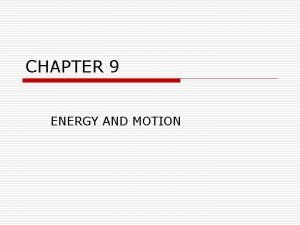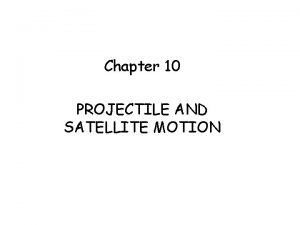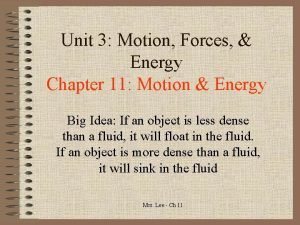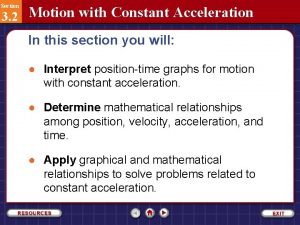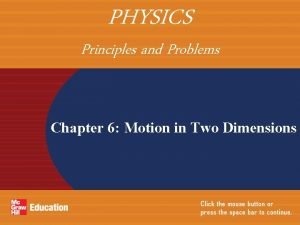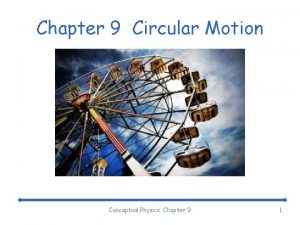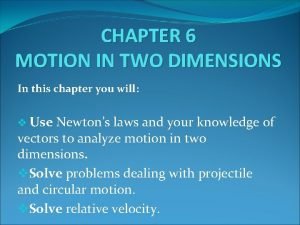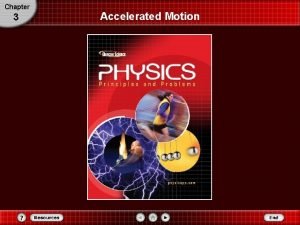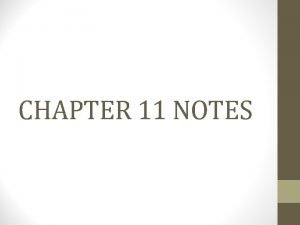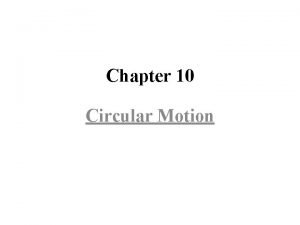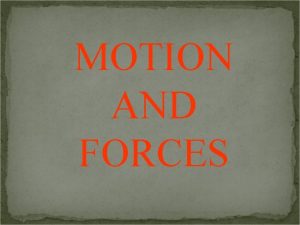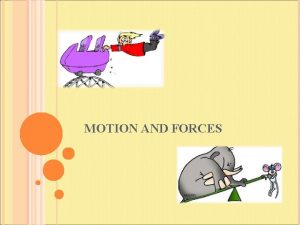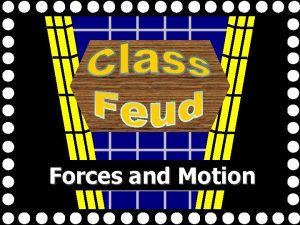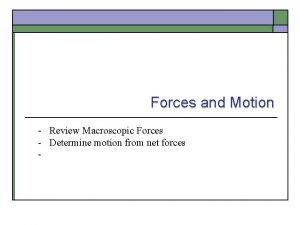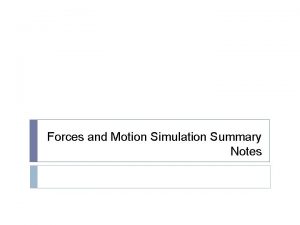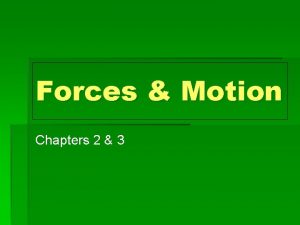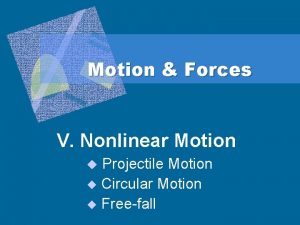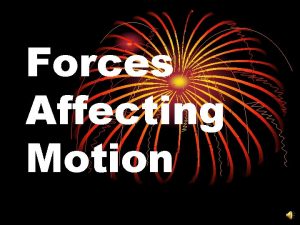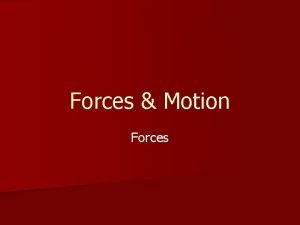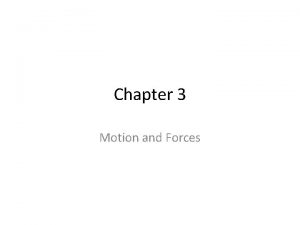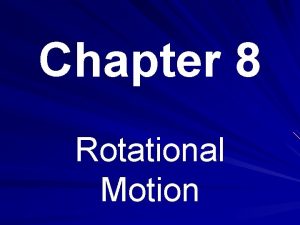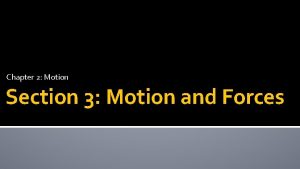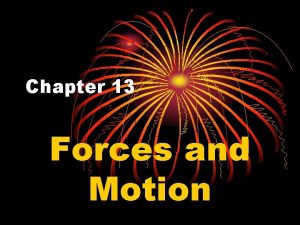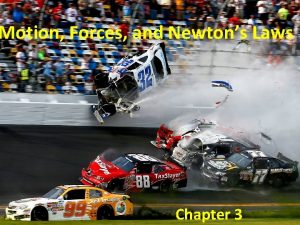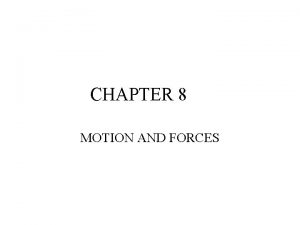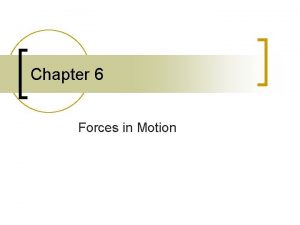Chapter 12 Forces and Motion 12 1 Forces




















































- Slides: 52

Chapter 12 Forces and Motion

12. 1 Forces and Motion 12. 1 Forces What is a Force? A force is a push or pull that acts on an object. l A force can cause a resting object to move, or it can accelerate a moving object by changing the object’s speed or direction. l

12. 1 Forces and Motion Units of Force is measured in newtons (N). l One newton is the force that causes a 1 kilogram mass to accelerate at a rate of 1 m/s/s. l A newton is equal to 1 kg-m per second (kg∙m/s 2). l

12. 1 Forces and Motion Representing Forces The direction and strength of a force can be represented by an arrow. l The direction of the arrow represents the direction of the force. l The length of the arrow represents the magnitude of the force. l

12. 1 Forces and Motion Combining Forces Force arrows can be combined to show the result of how forces combine. l Forces in the same direction add together and forces in opposite directions subtract from one another. l The net force is the overall force acting on an object after all the forces are combined. l

12. 1 Forces and Motion Balanced Forces Balanced forces are forces that combine to produce a net force of zero. l When forces on an object are balanced, the net force is zero and there is no change in the object’s motion. l An unlimited number of individual forces can act on an object and still produce a net force of zero. l

12. 1 Forces and Motion Unbalanced Forces An unbalanced force is a force that results when the net force acting on an object is not equal to zero. l When an unbalanced force acts on an object, the object accelerates. l

12. 1 Forces and Motion Friction All moving objects are subject to friction, a force that opposes the motion of objects that touch as they move past each other. l Friction acts at the surface where objects are in contact. l

12. 1 Forces l Forces and Motion There are four main types of friction: l static friction l sliding (kinetic) friction l rolling friction l fluid friction (drag)

12. 1 Forces and Motion Static Friction Static friction is the friction force that acts on objects that are not moving. l Static friction always acts in the direction opposite to that of the applied force. l

12. 1 Forces and Motion

12. 1 Forces and Motion Sliding Friction Once an object is moving, static friction no longer acts on it. l Instead, a smaller friction force called sliding (kinetic) friction acts on the object. l Sliding friction is a force that opposes the direction of motion of an object as it slides over a surface. l

12. 1 Forces l Forces and Motion Because sliding friction is less than static friction, less force is needed to keep an object moving than to start it moving.

12. 1 Forces and Motion Rolling Friction Rolling friction acts on rolling objects. l For a given set of materials, the force of rolling friction is about 100 to 1000 times less than force of static or sliding friction. l

12. 1 Forces and Motion Fluid Friction The force of fluid friction opposes the motion of an object through a fluid. l Fluid friction increases as the speed of the object moving through the fluid increases. l Fluid friction acting on an object moving through the air is known as air resistance. l At higher speeds, air resistance can become a significant force. l

12. 1 Forces and Motion Gravity is a force that acts between any two masses. l Gravity is an attractive force, that is, it pulls objects together. l Gravity is a field force in that it does not require objects to be in contact for it to act on them. l Earth’s gravity acts downward toward the center of Earth. l

12. 1 Forces and Motion Falling Objects Gravity causes objects to accelerate downward, whereas air resistance acts in the direction opposite to the motion and reduces acceleration. l As objects fall to the ground, they accelerate. l

12. 1 Forces and Motion If an object falls for a long time, the upward force of air resistance becomes equal to the downward force of gravity. l At this point, the forces acting on the object are balanced. l Acceleration is zero and the object continues falling at a constant velocity. l

12. 1 Forces l Forces and Motion Terminal velocity is the constant velocity of a falling object when the force of air resistance equals the force of gravity.

12. 1 Forces and Motion

12. 1 Forces and Motion Projectile motion is the motion of a falling object after it is given an initial forward velocity. l Air resistance and gravity are the only forces acting on a projectile. l

12. 1 Forces and Motion Figure 9 shows the motion of two balls released at the same time. l Figure 9 A shows that balls of different masses fall at the same rate. l Figure 9 B shows a ball given an initial horizontal velocity falls vertically at the same rate as a ball with zero horizontal velocity. l

12. 1 Forces and Motion The combination of an initial forward velocity and the downward force of gravity causes the ball to follow a curved path. l The two balls fall with the same vertical acceleration and strike the ground at the same time. l

12. 1 Forces and Motion

12. 1 Forces and Motion

12. 2 Newton's First and Second Laws of Motion Forces and Motion 12. 2 Newton’s First and Second Laws of Motion

12. 2 Newton's First and Second Laws of Motion Forces and Motion Newton’s First Law of Motion Newton summarized his study of force and motion in several laws of motion. l According to Newton’s first law of motion, the state of motion of an object does not change as long as the net force acting on the object is zero. l

12. 2 Newton's First and Second Laws of Motion Forces and Motion Unless an unbalanced force acts on it, l an object at rest remains at rest l an object in motion remains in motion with the same speed and direction. l Newton’s first law is sometimes called the law of inertia. l Inertia is the tendency of an object to resist a change in its motion. l

12. 2 Newton's First and Second Laws of Motion Forces and Motion Newton’s Second Law of Motion l An unbalanced, or net force causes an object’s velocity to change.

12. 2 Newton's First and Second Laws of Motion Forces and Motion The acceleration is directly proportional to the net force acting on the object. l Acceleration also depends upon the mass of the object (inversely proportional) l Mass is a measure of inertia of an object and depends on the amount of matter the object contains. l

12. 2 Newton's First and Second Laws of Motion Forces and Motion According to Newton’s second law of motion, the acceleration of an object is equal to the net force acting on it divided by the object’s mass. l The equation is a=F/m or more familiarly F=ma. l The acceleration of an object is always in the same direction as the net force. l

12. 2 Newton's First and Second Laws of Motion l Forces and Motion Newton’s second law also applies when a net force acts in the direction opposite to the object’s motion.

12. 2 Newton's First and Second Laws of Motion Forces and Motion

12. 2 Newton's First and Second Laws of Motion Forces and Motion Weight and Mass Although related to each other, mass and weight are not the same. l Weight is the force of gravity acting on an object. l An object’s weight is the product of the object’s mass and acceleration due to gravity acting on it. l The equation is W=mg. l

12. 3 Newton's Third Law of Motion and Momentum Forces and Motion 12. 3 Newton’s Third Law of Motion and Momentum Newton’s Third Law A force cannot exist alone. l Forces always exist in pairs. l According to Newton’s third law of motion, whenever one object exerts a force on a second object, the second object exerts an equal and opposite force on the first object. l

12. 3 Newton's Third Law of Motion and Momentum Forces and Motion These two forces are called action and reaction forces. l The forces are equal in size and opposite in direction. l The forces do not cancel each other because they act on different objects. l

12. 3 Newton's Third Law of Motion and Momentum Forces and Motion Momentum is the product of an object’s mass and its velocity. l The momentum for any object at rest is zero. l Momentum is calculated by multiplying an object’s mass (in kg) and its velocity (in m/s). l

12. 3 Newton's Third Law of Motion and Momentum Forces and Motion The formula is p=mv. l Momentum is measured in kg∙m/s. l

12. 3 Newton's Third Law of Motion and Momentum Forces and Motion Conservation of Momentum Under certain conditions, collisions obey the law of conservation of momentum. l In physics, conservation means that something has a constant value. l Conservation of momentum means that momentum does not increase or decrease. l

12. 3 Newton's Third Law of Motion and Momentum Forces and Motion A closed system means other objects and forces cannot enter or leave the system. l Objects within the system can exert forces on one another. l

12. 3 Newton's Third Law of Motion and Momentum Forces and Motion According to the law of conservation of momentum, if no net force acts on a system, then the total momentum of the system does not change. l In a closed system the loss of momentum of one object equals the gain in momentum of another object l momentum is conserved l

12. 3 Newton's Third Law of Motion and Momentum Forces and Motion Conservation of Momentum

12. 3 Newton's Third Law of Motion and Momentum Forces and Motion Conservation of Momentum

12. 4 Universal Forces and Motion 12. 4 Universal Forces Observations of planets, stars, and galaxies strongly suggest four different forces exist throughout the universe. l The four universal forces are l l electromagnetic l strong nuclear l weak nuclear l gravitational

12. 4 Universal Forces and Motion Electromagnetic Forces Electric and magnetic forces are two different aspects of the electromagnetic force. l Electromagnetic force is associated with charged particles. l Electric force and magnetic force are the only forces that both attract and repel. l

12. 4 Universal Forces and Motion Electric Forces Objects with opposite charges attract each other. l Objects with like charges repel each other. l

12. 4 Universal Forces and Motion Magnetic Forces Magnetic forces act on certain metals, on the poles of magnets, and on moving charges. l Magnets have two poles that attract each other. l Like poles repel each other. l

12. 4 Universal Forces and Motion Nuclear Forces l Two forces, the strong nuclear force and the weak nuclear force, act within the nucleus to hold it together.

12. 4 Universal Forces and Motion Strong Nuclear Force The strong nuclear force is a powerful force of attraction that acts only on the neutrons and protons in the nucleus. l Although this force acts over only extremely short distances, it is 100 times stronger than the electric force of repulsion at these distances. l

12. 4 Universal Forces and Motion Weak Nuclear Force The weak nuclear force is an attractive force that acts only over a range that is shorter than the strong nuclear force. l The existence of beta decay indicates that there must a force much weaker than the strong nuclear force. l

12. 4 Universal Forces and Motion Gravitational Force Gravity is the weakest universal force. l Gravitational force is an attractive force that acts between any two masses. l Newton’s law of universal gravitation states that every object in the universe attracts every other object. l F=G(m 1 m 2/d 2) l Value of G is 6. 67× 10 -11 N∙m 2/kg 2 l

12. 4 Universal Forces and Motion Gravity Acts Over Large Distances The gravitational force between two objects is proportional to their masses. l Gravitational force decreases with the square of the distance between the objects. l Gravity is the weakest universal force but it is the most effective force over long distances. l
 Chapter 12 forces and motion
Chapter 12 forces and motion Chapter 12 forces and motion
Chapter 12 forces and motion Chapter 2 motion section 1 describing motion answer key
Chapter 2 motion section 1 describing motion answer key The main difference between speed and velocity involves
The main difference between speed and velocity involves Chapter 2 motion section 1 describing motion answer key
Chapter 2 motion section 1 describing motion answer key Range of motion definition
Range of motion definition Balanced & unbalanced forces
Balanced & unbalanced forces Motion forces and energy
Motion forces and energy Friction mind map
Friction mind map Igcse physics forces and motion
Igcse physics forces and motion Forces and motion summary
Forces and motion summary Chapter 11 section 3 motion and force answer key
Chapter 11 section 3 motion and force answer key Forces and the laws of motion problem b
Forces and the laws of motion problem b Forces and motion jeopardy
Forces and motion jeopardy Motion forces and energy
Motion forces and energy Energy and forces unit test
Energy and forces unit test Study jams force and motion
Study jams force and motion Section 1 forces and motion answers
Section 1 forces and motion answers Terminal velocity igcse
Terminal velocity igcse Forces and motion
Forces and motion Like parallel forces definition
Like parallel forces definition What are some contact forces and some noncontact forces?
What are some contact forces and some noncontact forces? Unbalanced force
Unbalanced force Constructive forces and destructive forces
Constructive forces and destructive forces Shm formula
Shm formula An object in motion stays in motion
An object in motion stays in motion Describing motion worksheet answer key
Describing motion worksheet answer key Section 1 describing motion
Section 1 describing motion Net force and acceleration quick check
Net force and acceleration quick check How does force affect the motion of plants
How does force affect the motion of plants Apparent forces in circular motion
Apparent forces in circular motion Chapter 2 representing motion assessment answers
Chapter 2 representing motion assessment answers The forces shown above are
The forces shown above are Intermolecular vs intramolecular
Intermolecular vs intramolecular Intermolecular forces vs intramolecular forces
Intermolecular forces vs intramolecular forces Intramolecular forces vs intermolecular forces
Intramolecular forces vs intermolecular forces Conceptual physics chapter 5 projectile motion answers
Conceptual physics chapter 5 projectile motion answers Chapter 10 projectile and satellite motion tossed ball
Chapter 10 projectile and satellite motion tossed ball Section 1 describing motion
Section 1 describing motion Chapter 10 projectile and satellite motion tossed ball
Chapter 10 projectile and satellite motion tossed ball Mrs lee chapter 11
Mrs lee chapter 11 Chapter 16: electric forces and fields answers
Chapter 16: electric forces and fields answers Chapter 2 motion section 3 acceleration answers
Chapter 2 motion section 3 acceleration answers Physics principles and problems chapter 6 answers
Physics principles and problems chapter 6 answers Chapter review motion part a vocabulary review answer key
Chapter review motion part a vocabulary review answer key Describing and measuring motion
Describing and measuring motion Chapter 9 circular motion answers
Chapter 9 circular motion answers Chapter 6 study guide motion in two dimensions
Chapter 6 study guide motion in two dimensions Chapter 6 motion in two dimensions
Chapter 6 motion in two dimensions Chapter 3 study guide accelerated motion
Chapter 3 study guide accelerated motion Chapter 23:1 performing range of motion exercises
Chapter 23:1 performing range of motion exercises Chapter 11 section 2 acceleration answer key
Chapter 11 section 2 acceleration answer key Chapter 10 circular motion
Chapter 10 circular motion
